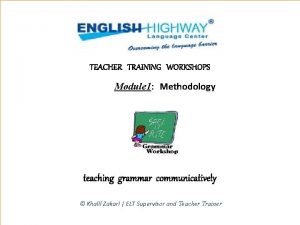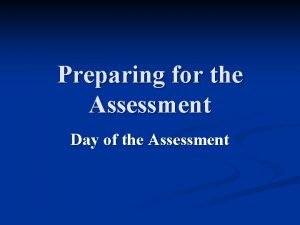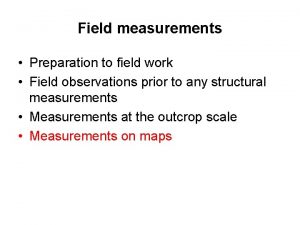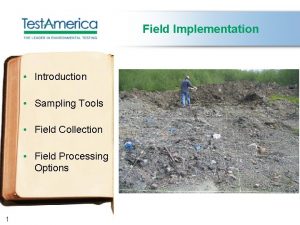Module 1 Field History Preparing for field assessment















- Slides: 15

Module 1 Field History Preparing for field assessment Determine your survey approach Extension agent Wayne Cooley, ARS agronomist Randy Anderson, and farmer Gilbert Lindstrom Photo by Scott Bauer

Field History • • Ask questions! Get records, if possible Make general observations Learn to detect what might be causing the problem

Field History • • Previous crop Chemical history Planting date Variety and seed lot Tillage methods Soil amendments Weather Movement of soil into field

Preparation for Field Assessment • Successful diagnosis starts with good preparation • Keep some useful tools around, and think about the history (as you know it) and nature of the concern

Preparation for Field Assessment • Notepad, recordkeeping form or handheld computers • Proper clothing, for safety • Always observe appropriate re-entry intervals (REI)

Preparation for Field Assessment • Hand lenses magnify tiny features that may be useful • Common magnifications – – 4 X 10 X 16 X 20 X

Aphid Magnification English grain aphid

Rust magnification example Barley rust photo: Vernyl Pederson

Preparation for Field Assessment Other useful tools • • Trowel Knife Plastic baggies Vial – with alcohol for insects • Camera – digital/35 mm • Bucket • Sweep net

Determine Survey Approach • Surveying (or scouting) requires consideration of approach or pattern of travel • Specific concerns may dictate a certain type of scouting method • Regardless of method – the goal is to get a representative sample

Determine Survey Approach • Scouting routes may be modified by: – topography – soil types – irrigation channeling – field entrances • Regardless of the approach, the goal is to get a representative idea of the problems

Determine Survey Approach • Scouting in a W or Z pattern for pests or problems distributed uniformly over the field Examples: Foliar diseases later in season; European corn borer; Pesticide damage

Determine Survey Approach • Scouting or sampling in areas where pests or damage may be concentrated Examples: root rots associated with low areas or in patches; cutworms in low, cool areas; white grubs

Determine Survey Approach Pests or damage associated with field borders or waterways Examples: grasshoppers, chinch bug

Determine Survey Approach Number of sites to visit in the field Sampling or surveying usually is done at 5 sites per 40 to 50 acres
 C device module module 1
C device module module 1 Self assessment module 3
Self assessment module 3 Teaching and assessment of grammar module 1
Teaching and assessment of grammar module 1 Fairfs
Fairfs Fspos vägledning för kontinuitetshantering
Fspos vägledning för kontinuitetshantering Novell typiska drag
Novell typiska drag Tack för att ni lyssnade bild
Tack för att ni lyssnade bild Returpilarna
Returpilarna Varför kallas perioden 1918-1939 för mellankrigstiden
Varför kallas perioden 1918-1939 för mellankrigstiden En lathund för arbete med kontinuitetshantering
En lathund för arbete med kontinuitetshantering Kassaregister ideell förening
Kassaregister ideell förening Tidbok yrkesförare
Tidbok yrkesförare A gastrica
A gastrica Förklara densitet för barn
Förklara densitet för barn Datorkunskap för nybörjare
Datorkunskap för nybörjare Stig kerman
Stig kerman





























